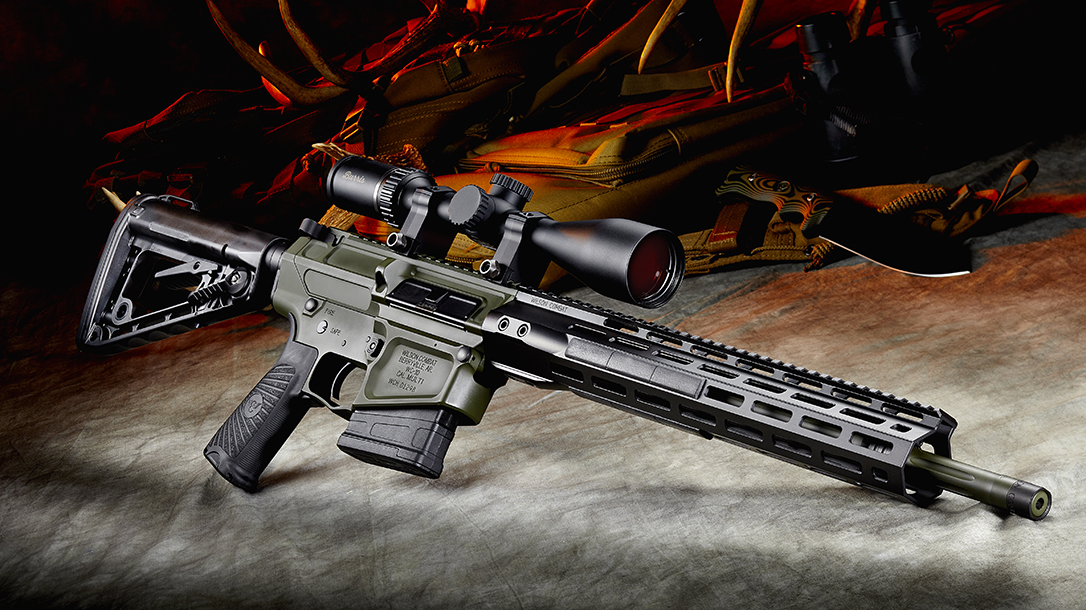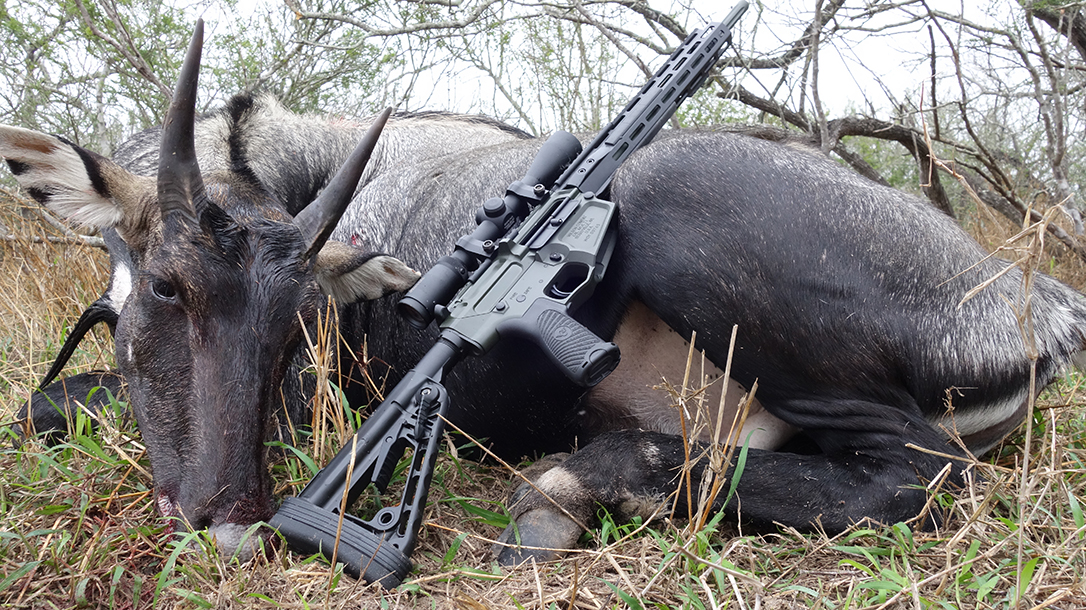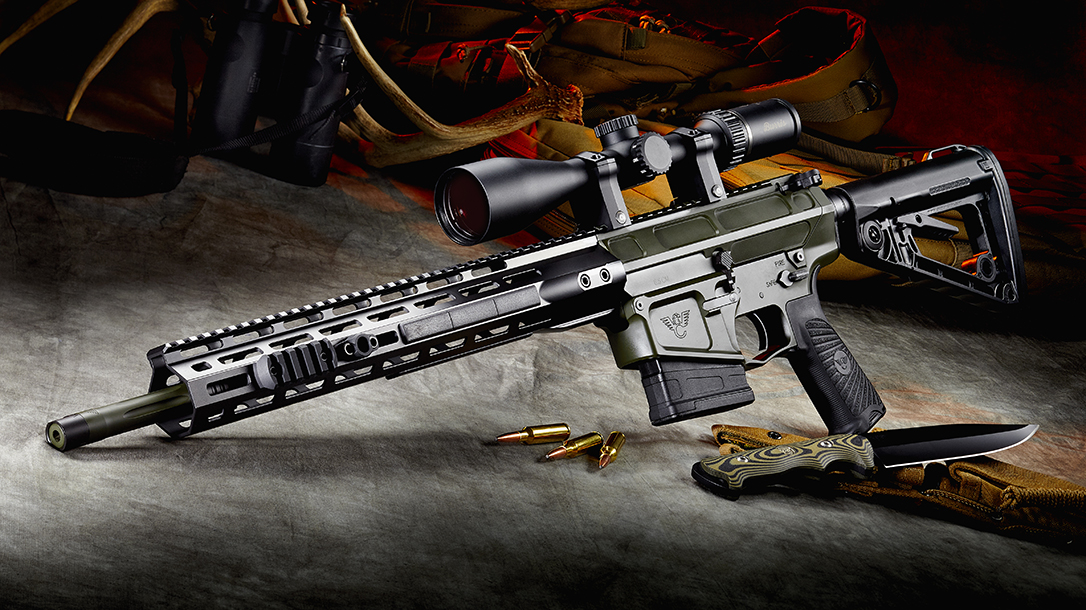There aren’t many ways to make a Wilson Combat rifle better, but hunting with one next to the legend, Bill Wilson, is one of them. I had that chance after Bill invited me to join him and a few close friends at the 853,000-acre King Ranch just west of Kingsville, Texas, to hunt nilgai.
What’s a nilgai (also known as blue bull)? Before I hunted one, I would have told you it’s India’s largest antelope. Now I’ll say it’s the smartest, toughest, sharpest-eyed critter I’ve seen. Both descriptions are still true. Other far-more-qualified hunters share my sentiments. Bill, who has hunted about every animal on the planet, has a lot of respect for nilgai, too. “I don’t think there’s anything in North America as tough as a nilgai, other than the big bears,” he said.
Advertisement — Continue Reading Below
Ready To Hunt
Let’s circle back to why I was invited to Texas. Bill wanted me to hunt one of the world’s toughest critters to see how good Wilson Combat’s Tactical Hunter was in the field. A few months before my February hunt, Wilson Combat introduced its new AR-10-style platform to gun writers and editors at Athlon Outdoors’ exclusive Rendezvous in Colorado. Little did I know that was the rifle I would later use on what turned out to be the greatest hunt of my life.
Why did Wilson Combat develop such a rifle? “Primarily because I’m a serious hunter, hunt with ARs almost daily and wanted the best package for hunting we could produce,” Bill said. “Also, because this is a market segment that hasn’t been properly served, in my opinion.”
Many firearms manufacturers make good AR-10-style rifles. But good has never been enough for Bill, and as with most of his weapons, he believed there was more customers could demand from high-end builds. He gave it to them in three flavors: the Ultimate Hunter, Ultralight Hunter and Tactical Hunter.
Advertisement — Continue Reading Below
Wilson’s Hunting Rifles
“The primary goals of the project were to make the rifles as light as possible while still retaining stellar accuracy,” Bill said. “I personally shot thousands of rounds, optimizing the accuracy of the barrels used in the Hunter series to optimize them for hunting bullets. The Ultimate Hunter and Tactical Hunter are basically the same rifle with the exception of the threaded muzzle and buttstock.
The Ultralight Hunter is designed to be the lightest we can build it while still retaining stellar accuracy and fast handling characteristics. I was the lead on all the design work and personally did all the testing for the Hunter series project. A lot of different components were tested to optimize the system, and I personally shot thousands of rounds of factory and handloaded ammunition in testing for function, durability and accuracy. This resulted in rifles that are totally reliable, durable and extremely accurate with common hunting bullets, especially with handloads.”
In fact, one of Bill’s handloaded 210-grain Nosler Partition rounds would have the last word if I had a conversation with a nilgai. When you hunt with Bill, you don’t just use a rifle, and you sure as hell don’t feed it just any old ammunition. When I got to Texas, Bill’s personal Tactical Hunter in .338 Federal was waiting for me. It sported an 18-inch barrel with a 4-pound, two-stage Tactical Trigger Unit, and to suit Bill’s tastes, the barrel was crowned and not threaded. Bill enhanced the Tactical Hunter with two remarkable tools: a magazine full of handloaded 210-grain Nosler Partitions pushed by 42 grains of Benchmark powder and a simple Burris 3-9x40mm Fullfield II riflescope. Bill handpicked that bullet and optic because he knew I’d need them.
Advertisement — Continue Reading Below
The Wilson Difference
If you’ve priced ARs lately, you’ll notice anything with the words “Wilson Combat” on it costs more. It’s because they’re better. Bill, and his son, Ryan Wilson, spare no expense when they create a rifle, pistol or shotgun that bears the company name. Here’s one example: In this particular development, they used S7 tool steel for bolt stops, proudly proclaiming they’ve never had one break, even though AR-10-platform bolt stops are notorious for that industry-wide.
“We have spared no expense in the development, testing and production of these rifles,” Bill said. “If we could build a better one, we would. A big advantage Wilson Combat has is the fact that I’ve been a serious hunter since the early ’70s and have a very keen personal interest in Wilson Combat making the very best ARs on the market, whether for hunting or tactical use. I’m shooting and testing AR products virtually on a daily basis. Here at the ranch, we are fortunate to have shooting ranges out to 800 yards for extensive accuracy testing. Also, I hog hunt at least 325 days out of the year, plus I’m deer hunting over 120 days of those 325, with annual harvests of 200-plus hogs and 50-plus deer, all with ARs. Who else proves out their product like that?”
Gearing Up with the Wilson Combat Tactical Hunter
Even his relentless testing wasn’t good enough, as Bill insisted on putting one of his most advanced ARs in my hands to go after the toughest animal I’d hunted just a few months after major neck surgery. I’d need one of the best, lightest and softest-shooting rifles to succeed, and that’s what Bill was counting on.
Advertisement — Continue Reading Below
If you’ve hunted with an AR, “light” and “ergonomic” are terms that probably eluded you. I know that was true with me. My career in the military gave me plenty of carry time with M4s weighed down with mission-essential bells and whistles. I don’t have fond memories of carrying my rifles, and to be honest, an AR isn’t the first hunting rifle I’d reach for. Well, until I hunted nilgai.
The King And I
Hunting at the King Ranch is, I’m told, almost identical to African plains game spot-and-stalk-style hunting. The western Texas ranch boasts plenty of world-class whitetails, feral hogs, Rio Grande turkeys, coyotes and exotic but savvy transplanted game from around the world. We got a lot of windshield time trying to find bulls, but most of the day was spent—and sometimes seemingly wasted—wearing out the soles of my Lowa Renegade boots when we’d spot, get spotted and then watch 500-pound animals run almost 40 mph away from us. Only twice did I get to do what anyone would classify as a stalk, with one having one of the most humiliating endings I’ve experienced.
Now, back to that fantastic rifle. The Tactical Hunter Bill issued me was chambered in the wildly underrated .338 Federal. If you’re unfamiliar with the cartridge, imagine a .308 Winchester that spent a lot of time in the gym working out. The cartridge is nothing more than the .308 case necked up to the beefier .338 caliber.
Advertisement — Continue Reading Below
Heavy Hitters
“The 338 Federal and .358 Winchester are substantially more powerful than the .308,” Bill said. “Both are underrated for what they’re capable of, and I don’t know why they’re not more popular.”
By the end of the hunt, I was a fan of the .338 Federal and insisted on being the grand marshal at its ballistics parade.
Bill talked more about bullets than he did cartridges because, according to him, that’s how it should be. “People always think caliber, but the first thing they need to think about is bullet selection and shot placement,” he said. “Can you get a bullet to do what you want it to do, and can you put it where it needs to be?”
Advertisement — Continue Reading Below
To The Field
My first encounter with a nilgai wasn’t on my first hunt but rather the hunt of Jon Wayne Taylor, a fellow gun writer and veteran. We were paired with the King Ranch’s wildlife biologist, Weston Koehler, and because Jon only had 24 hours in camp to get a bull, I quickly bowed out so the team could focus on him. Jon was using Wilson Combat’s new .458 HAM’R Ultimate Hunter in a unique hybrid AR somewhere between an AR-15 and AR-10 size-wise.
The .458 HAM’R ran in what Wilson Combat calls its “WC-12” platform, and Bill handloaded ammunition for Jon that pushed a 300-grain Barnes TTSX bullet at 2,100 fps out of the gun’s 18-inch barrel. After some trial-and-error stalks for Weston and Jon, where I volunteered to stay in the truck to minimize spooking antelope, I was invited to join the next stalk and would earn the title of Jon’s lucky charm, as he took a mature trophy bull up close with the .458 HAM’R.
Next Up
With Jon’s bull in the freezer, I hunted with a clear conscious and a much slower game clock. Weston and I covered quite a few acres of western Texas ranch land. I saw plenty of nilgai, but mostly cows and immature bulls. You don’t shoot a spike nilgai, even on your first hunt, and Weston could field-judge a trophy bull faster than I could repeatedly ask, “Is that a shooter?”
Advertisement — Continue Reading Below
We drove a lot. We walked a lot more. I didn’t fall in love with the Wilson Combat Tactical Hunter when I shouldered it to fire on a nilgai. No, I fell in love with the light, ergonomic .338 Federal late in the day, when I was tired, my legs felt like cement and my body was rudely reminding me that just a few months earlier I had a titanium plate screwed into my C4/C5 vertebrae. The gun never felt heavy—not when I bounced out of bed to hunt, not when I strutted through the brush on well-rested stalks and not when I dragged my body just one more mile with Weston looking for a trophy nilgai. It was the perfect hunting rifle, and it was a big-bore AR.
Nilgai Fever
Later in the evening, Weston spotted a good bull several hundred yards away. The bull was feeding, and although he was taking his time munching on vegetation, he moved fast enough for us to have to flank him. So, into the wind and up the hill we went. Then, we hid in scrub oaks and waited. Three hundred yards. Too far. Then 275 yards. Too far. Then 250 yards. Too far.
We were losing light, and the bull was wandering to the left, right and in circles, so Weston sneaked us down the hill and within 200 yards broadside of a trophy bull. To his credit, he tried to set me up for success. He reviewed the shot and ranged and re-ranged the distance. Then he reminded me to shoot for the shoulder and not behind it, because a nilgai’s vitals are forward of those of a deer, protected by those massive front shoulders. He reminded me to breathe, get a good sight picture, squeeze the trigger and wait for the right shot.
Advertisement — Continue Reading Below
Swing … and a Miss
He did everything he could—and I missed. Then I missed again. Then I saw the look a few honest hunters have seen from our hunting partners. My heart sank, and my head dropped. My feet dragged, and then I had to tell one of the greatest firearms manufacturers and hunters I’ve ever known that I just missed a once-in-a-lifetime nilgai with his perfect rifle in the most imperfect way. I expected to be drawn, quartered and hung next to Jon’s nilgai. But what I got was humility and fatherly words only a good man like Bill can say. “It happens,” he said. “Shake it off, and go back out there.”
I didn’t sleep that night. I rehearsed that shot again and again. I’d love to say it had been a malfunction, or that the optic was off, a wild hog jumped in front of my rifle or there was an earthquake. But there wasn’t. I just choked.
Reboot
The next morning, I was ready much earlier than usual. I ate a bigger breakfast. I gave myself a Knute Rockne speech in the bathroom. Then, I stepped outside and saw that God would make me earn my redemption the hard way—or not at all. Fog covered the King Ranch. I don’t mean pretty, artsy, make-everything-cool-looking fog, either. I mean heavy how-the-hell-will-I-ever-see-a-grayish-black-antelope-in-this-stuff fog.
Weston seemed undaunted. So, I picked up the set of brass balls it took for me to admit to Bill I’d missed a trophy bull nilgai, grabbed the Wilson Combat Tactical Hunter and we headed out. It didn’t take long for Weston to spot a trophy bull. The guy, no doubt a ringer for any game of Where’s Waldo, had a knack for finding nilgai. So, after a short stalk, I held my .338 Federal with a massive bull nilgai 130 yards in front of me.
At first, I saw his shape. Then, when I put the optic on him, I saw everything. I saw the animal, the fog, the trees. I saw what was in front, behind and to the left and right of him. And finally, I saw his shoulder clearly as I walked the scope’s crosshairs up to the sweet spot. At such times, during visually muddy conditions, you need an optic with good contrast, and that’s optically clear and bright. The Burris had those in spades. So, I dug my feet in a little deeper. I held the gun a little tighter, and I didn’t hope for a good shot, I demanded it. Then I squeezed the trigger, and after Weston heard the smack of a well-placed shot, I saw him smile and jump out of the way as an 800-pound gorilla leaped off my back and ran into the Texas fog.
Redemption with the Wilson Combat Tactical Hunter
I never got off a second shot. Thankfully, I didn’t need one. The 210-grain Partition double-lunged the mighty bull antelope, a potential entry into the Safari Club International record books. After a brief sprint, he piled up in the brush, never dropping any blood despite having an entry and exit hole.
The taste of victory seems a bit sweeter when you sprinkle a little humility on it. The rifle, the bullet and, wow, that little Burris optic did their jobs like they always do. That time, I finally did mine.
If you’re in the market for a semi-automatic rifle like the Wilson Combat Tactical Hunter, pass over the good-enough manufacturers and save your money. You probably won’t get to go on a hunt with Bill by your side. But when you carry one of his rifles, he’ll be with you. And that kind of magic is worth the extra money.
For more information, visit wilsoncombat.com.
Wilson Combat Tactical Hunter Specifications
- Caliber: .338 Federal
- Barrel: 18 inches
- OA Length: 35 inches
- Weight: 7.69 pounds (empty)
- Stock: Rogers/Wilson Super-Stoc
- Sights: None
- Action: Direct impingement semi-auto
- Finish: Armor-Tuff
- Capacity: 10+1
- MSRP: N/A

























